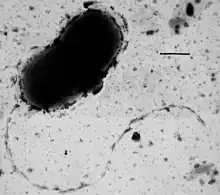Thermodesulfobacteriota
| Thermodesulfobacteriota | |
|---|---|
 | |
| Desulfovibrio vulgaris | |
| Scientific classification | |
| Domain: | Bacteria |
| Phylum: | Thermodesulfobacteriota Garrity & Holt 2021[1] |
| Classes[2] | |
| |
| Synonyms[2] | |
| |
The Thermodesulfobacteriota are a phylum[3] of thermophilic[4] sulfate-reducing bacteria.
A pathogenic intracellular thermodesulfobacteriote has recently been identified.[5]
Phylogeny
The phylogeny is based on phylogenomic analysis:[2]
| |||||||||||||||||||||||||||||||||||||||||||||||||||||||||||||||||||||||||||||||||||||||||||||||||||||||||||||||||||||||||||||||||||||||||||||||||||||||||||||||||||||||||||||||||||||||||||||||||||||||||||||||||||||||||||||||||||||||||||||||||||||||||||||||||||||||||
References
- ↑ Oren A, Garrity GM (2021). "Valid publication of the names of forty-two phyla of prokaryotes". Int J Syst Evol Microbiol. 71 (10): 5056. doi:10.1099/ijsem.0.005056. PMID 34694987.
- 1 2 3 Waite DW, Chuvochina M, Pelikan C, Parks DH, Yilmaz P, Wagner M, Loy A, Naganuma T, Nakai R, Whitman WB, Hahn MW, Kuever J, Hugenholtz P. (2020). "Proposal to reclassify the proteobacterial classes Deltaproteobacteria and Oligoflexia, and the phylum Thermodesulfobacteria into four phyla reflecting major functional capabilities". Int J Syst Evol Microbiol. 70 (11): 5972–6016. doi:10.1099/ijsem.0.004213. PMID 33151140.
- ↑ Vick TJ, Dodsworth JA, Costa KC, Shock EL, Hedlund BP (March 2010). "Microbiology and geochemistry of Little Hot Creek, a hot spring environment in the Long Valley Caldera". Geobiology. 8 (2): 140–54. doi:10.1111/j.1472-4669.2009.00228.x. PMID 20002204.
- ↑ Jeanthon C, L'Haridon S, Cueff V, Banta A, Reysenbach AL, Prieur D (May 2002). "Thermodesulfobacterium hydrogeniphilum sp. nov., a thermophilic, chemolithoautotrophic, sulfate-reducing bacterium isolated from a deep-sea hydrothermal vent at Guaymas Basin, and emendation of the genus Thermodesulfobacterium". Int. J. Syst. Evol. Microbiol. 52 (Pt 3): 765–72. doi:10.1099/ijs.0.02025-0. PMID 12054236.
- ↑ Schmitz-Esser S, Haferkamp I, Knab S, et al. (September 2008). "Lawsonia intracellularis contains a gene encoding a functional rickettsia-like ATP/ADP translocase for host exploitation". J. Bacteriol. 190 (17): 5746–52. doi:10.1128/JB.00391-08. PMC 2519521. PMID 18606736.